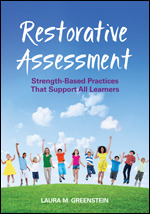Restorative Assessment
Strength-Based Practices That Support All Learners
- Laura M. Greenstein - Montville Public Schools, University of New Haven, USA, University of Connecticut, USA
Formative Assessment | Teaching At-Risk Students | Teaching Strategies for Diverse Students
Encourage achievement with assessments that promote growth—for every student!
Imagine a classroom where students can’t wait to take tests. A dream? Maybe. But when you make restorative assessment part of your classroom culture, your students are more likely to feel safe, ready for challenges, and eager to showcase their knowledge whenever they have the chance.
Unlike ordinary testing, restorative assessments offer students multiple ways to demonstrate their learning—promoting equity and reducing conflict in the classroom. Since assessments happen regularly, you have more opportunities to check student progress and tailor your teaching accordingly. In this guide, you’ll find:
- Real-world examples of restorative assessment in practice
- Cutting-edge research on personalized learning and assessment
- Practical strategies for implementation
- Action points and reflection questions
In today’s diverse classrooms, one-size-fits-all learning is a thing of the past. Empower your teaching—and your students—by mastering restorative assessment and helping every student grow.
Sister Camille Anne Campbell, President
Mount Carmel Academy
"Why waste time on assessment for just more data when you can have assessment that is restorative and intentionally creates more learning opportunities for all students? This book offers the structure for a purpose-driven assessment system that uses student-centered formative assessments as a means to respond to learning, re-engage students and immediately deliver specific, appropriate instruction to allow all students to succeed."
Renee Peoples, Teaching and Learning Coach
Swain West Elementary
Free resources
The Remarkable Powers of Engagement
Engagement has become a buzz word in education. Teachers face pressure to keep their students active, but bustle and busyness are not the same as engagement. Worksheets and on-line tutorials may keep learners occupied, but not necessarily engaged. Read this blog from Laura Greenstein, author of Restorative Assessment, for a better understanding of what engagement truly is and how you can boost engagement in your classroom.
"Restorative Assessment provides excellent information and training for teachers and an in-depth understanding of students of today. The practices recommended in this book will transform schools and create challenging, healthy learning environments for all children."
"Restorative Assessment challenges the present way of looking at assessment through research-based information. Restoring assessment to its rightful place as an integral part of teaching rather than a separate entity is critical to positive student outcomes and overall success!"
"Why waste time on assessment for just more data when you can have assessment that is restorative and intentionally creates more learning opportunities for all students? This book offers the structure for a purpose-driven assessment system that uses student-centered formative assessments as a means to respond to learning, re-engage students and immediately deliver specific, appropriate instruction to allow all students to succeed."
